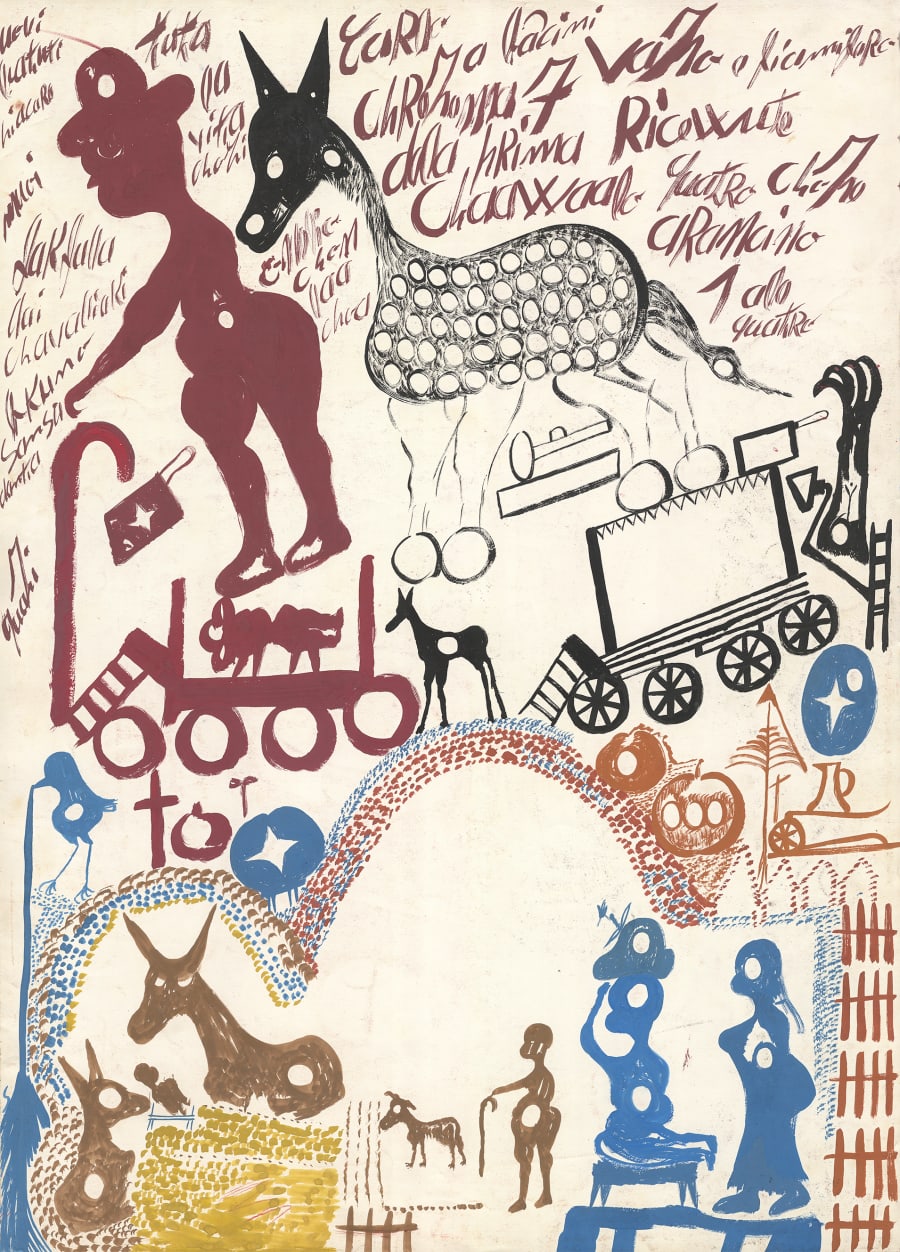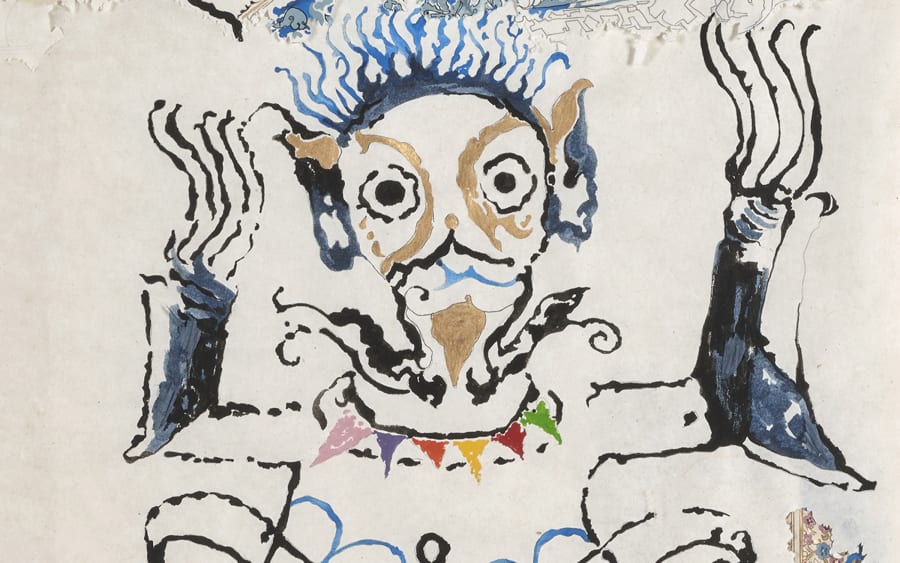Lou Fauroux
Exo Exo
What if the web disappeared forever? A child of Gen Z, surrounded by screens; a computer geek and a professional hacker; Lou Fauroux imagines this science-fiction scenario, somewhere between utopia and dystopia. For Exo Exo’s first participation at Art Basel Paris, she presents a 3D film in several episodes, unfolding on 10 vertical screens arranged in a circle. As in a series, each sequence follows a new character affected by this global crisis who, to remedy the situation, goes to an Internet detox center run by... the Kardashian family. On the wall, the young French artist responds to the film with several bas-relief assemblages of batteries, chips, and other electronic components, like the future vestiges of a disconnected world. Butterflies appear on these compositions, embodying a hypothetical springtime when nature reclaims its rights.
Nuri Koerfer
Lars Friedrich
In Nuri Koerfer’s world, tables have dog heads, boots have alligator mouths, and chairs have dolphins for armrests. Known for fusing animals and furniture in disconcerting sculptures, the Swiss artist has been developing her own daydream-like fantasies for the past 15 years, with Berlin’s Galerie Lars Friedrich unveiling the latest example at the fair. Here, we encounter three shelves of varying sizes – up to 2.3 meters high – as well as a seat, from which emerge several donkey heads, an animal that holds a special place for Koerfer. The 43-year-old artist creates this illusion by building wooden structures covered in papier-mâché, which she then paints in monochrome tones and varnishes with epoxy resin to give them a shiny appearance. An effect that further blurs the boundaries between object and beast.
Kenji Ide
Kayokoyuki
For the past 15 years, Kenji Ide has been perfecting the art of squeezing a world into a handkerchief. With his miniature assemblages of wood and found objects, like architectural models composed of various geometric shapes – spheres, crosses, vertical rods – and more recognizable elements – feet, flowers – the Japanese artist has formed his own enigmatic vocabulary. For Tokyo gallery Kayokoyuki, he unveils a new three-dimensional rebus, spread over two display pedestals. Playing on the proportions and repetition of forms, the sculptor evokes the game of seduction between two individuals, indicated by the title of the work, Boy Meets Girl, a reference to Leos Carax’s film of the same name. Who would have thought that small abstract wooden sculptures could conceal romance?
Steffani Jemison
Madragoa
Age-old and universal, the dream of flight has given rise to a great deal of scientific research, sometimes leading to revolutionary inventions, but also to numerous texts and works of art. With an immense cyclorama (a theatrical device in which a curtain is hung in a semicircle at the back of the stage to create an effect of immensity) Madragoa and artist Steffani Jemison create the ideal backdrop to give free rein to this fantasy. Fascinated by the image and its potential, the American incorporates never-before-seen photographs inspired by the myth of Icarus, in which bodies seem to levitate in front of distant skyscrapers. To accentuate the effect of movement and give life to the frozen image, the artist uses lenticular printing to give relief, while superimposing other shots. When the viewer moves, the figures appear to move; an invitation to follow them into the atmosphere.
Xavier Robles de Medina
Catinca Tabacaru Gallery
Singer Aaliyah as the vampire queen in the film Queen of the Damned (2002); Xavier Robles de Medina’s brother disguised as a ninja; the evil tree from Walt Disney’s Snow White and the Seven Dwarfs (1937). In the mind of the Surinamese artist, these images – which belong at first glance to radically opposed universes – are implicitly linked in his own memory and translated into three works at the Catinca Tabacaru Gallery booth. Using acrylic on wood, Robles de Medina’s hyper realistic lines create a vibrant, almost dreamlike image. Driven by the idea of ‘confronting contemporary culture,’ the Berlin-based artist draws on our collective unconscious and the images that run through it to speak of exoticization, otherness, and cultural hegemony.
Sophie Thun
Sophie Tappeiner
For Sophie Thun, the artist’s studio, a place usually kept secret, has become a central artistic subject. So much so, that this year the German photographer has invited it to the Grand Palais. On metal panels, she has fixed black-and-white shots of her workspace. We can make out plotters, doors, white backgrounds, and tripods, between which the face of the 30-something artist appears furtively, breaking the invisible fourth wall that stands between the work and the viewer. Always accompanied by a smaller photogram of the artist’s hands, Thun’s compositions overflow beyond the limits of the frame to become part of the gallery booth itself. Thun’s approach echoes the work of photographer Paul Mpagi Sepuya, famous for using his studio as the setting for his photographs and self-portraits.
Bruno Zhu
What Pipeline
Spotted last year at Paris Internationale, where he presented gift boxes in the shape of spades, diamonds, and hearts, Bruno Zhu once again demonstrates his offbeat sense of humor. Here he takes the vocabulary of advertising and mixes it with the very domestic vocabulary of textiles and the decorative arts – with which he is very familiar, having graduated in fashion design. He calls out to us with a huge ‘V O I L À ! ?’ written on the wall, where each letter is formed by a long shirt sleeve cut from a different fabric (blue-and-white stripes, pink gingham…) while the accent is marked with a fedora. The artist completes these giant ‘sleeves’ with an accessory: a cotton watch, no less imposing, upholstered in a slightly old-fashioned music paper print. It is the finishing touch to the absurd staging, which the gallery itself describes as ‘sexy and ridiculous.’
Lungiswa Gqunta
Whatiftheworld
Wild plants, rocks, and streams: Lungiswa Gqunta’s installation appears to invite us to take a breath and immerse ourselves in the landscape sketched out on the floor and walls. Yet the South African artist’s work assumes an artificial aspect. The stones are in fact made of red clay, bearing the marks of the fingers that shaped them, while the end of the stream is made of electric-blue barbed wire, tamed to draw sinuous lines. A symbol of imprisonment and oppression, this material of choice for the artist enables her to evoke the colonial history of her homeland, and in particular the relationship to the British and the Boer colonists. Keen to evoke the stigma of colonization and the inequalities that still persist today, Lungiswa Gqunta also presents black-and-white photos of the sacred imphepho plant, believed to guarantee immortality in Zulu culture, printed on textiles. These more intimate works overcome the mechanisms of oppression by reconnecting with nature and its ancestral mysticism.
Art Basel Paris will take place from October 18 to 20, 2024, at the Grand Palais. Discover the participating galleries of the Emergence sector here.
The Galeries Lafayette group is the Official Partner of the Emergence sector.
Matthieu Jacquet is a writer based in Paris.
Caption for header image: Xavier Robles de Medina, Aaliyah, Queen of the Damned. Directed by Michael Rymer, Warner Bros. Pictures, 2023-2024. Courtesy of the artist and Catinca Tabacaru.
Published on October 3, 2024.


